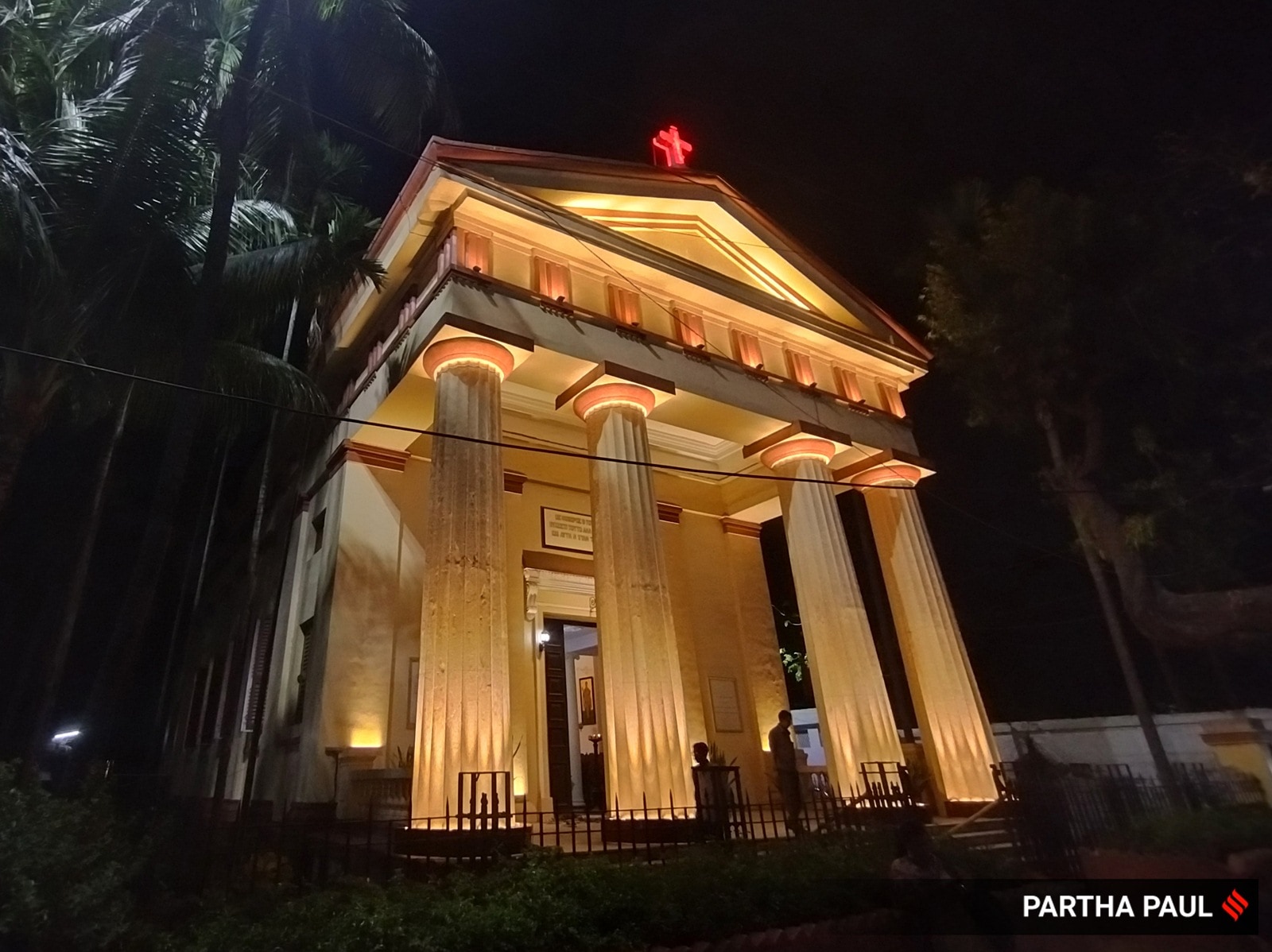Restoring Kolkata’s Pride: Why city’s heritage buildings are lit up in night and who are behind it
“Calcutta is the only city, which the British built from scratch and some of the architecture and buildings are incredible, but those are not visible at night,” he said.
 Portuguese Church on Brabourne Road, founded in 1799, also known as Cathedral of The Most Holy Rosary. Partha Paul
Portuguese Church on Brabourne Road, founded in 1799, also known as Cathedral of The Most Holy Rosary. Partha PaulKolkata’s skyline is now lit up by illuminated heritage buildings that were barely visible at night not so long ago. Spearheading the initiative is Mudar Patherya, a prominent figure in Kolkata’s heritage preservation efforts who vowed to “illuminate the structures at night”.
“Calcutta is the only city, which the British built from scratch and some of the architecture and buildings are incredible, but those are not visible at night,” he said.
Patherya collaborated with 20 different sponsors to secure budgets for the project — ‘The Kolkata Restorers’. “The budget depends on the architecture varying in between 1 lakh-2.5 lakhs,” says the shareholder, who has completed illumination projects at 22 distinct locations across Kolkata till now. These projects include the restoration and enhancement of various ranging from religious sites to public buildings and private residences.
“Illumination was essential, we knew that painting the structures wouldn’t serve the purpose,” said Patherya, adding that they opted for a warm yellow tone, as it accentuates architectural refinement.
“After understanding the architecture, it was clear that merely putting halogen light in the bottom will not enhance the beauty and so we used yellow lights to illuminate the structures,” he said.
 The Cathedral of the Most Holy Rosary, commonly referred to as the Portuguese Church, situated in Burrabazar, Kolkata, was established in the year 1799 and serves as the principal cathedral for the Roman Catholic Archdiocese of Calcutta. (Express photo by Partha Paul)
The Cathedral of the Most Holy Rosary, commonly referred to as the Portuguese Church, situated in Burrabazar, Kolkata, was established in the year 1799 and serves as the principal cathedral for the Roman Catholic Archdiocese of Calcutta. (Express photo by Partha Paul)
Patherya’s work includes the illumination of prominent landmarks such as the Bible Society building, established in 1811; the Greek Orthodox Church, located in Kalighat tram depot and constructed in 1925; St. James’ Church on AJC Bose Road, constructed in 1862; St. Mary’s Church on Elgin Road, popularly known as the “Bangli Cathedral”; Maghen David Synagogue on Canning Street, the Port Clock Tower, the Auxilium Church and the Portuguese Church on Brabourne Road, founded in 1799, also known as the Cathedral of The Most Holy Rosary. It is the first Catholic place of worship in Kolkata.
The other structures illuminated under the project include the Maniktala Market, on Vivekanand Road featuring dome painting; historic Sree Sree Kalachand Ishwar Jiu Mandir on Ramdulal Sarkar Street; religious structures like the Kapalitola Kali Mandir at 42 Chittaranjan Avenue, the Sacred Heart Church of Lenin Sarani (underwent clock repair); Park Court at Park Circus junction; the Royal Insurance building, founded in 1845, that was designed by architects Edward Thornton and PWD architect William Banks Gwyther; the Royal Calcutta Turf Club, founded in 1847 in Calcutta, have also been illuminated by the group.
The New Market facade and clock tower, constructed in Gothic style, echo its Victorian heritage. The clock was imported from Huddersfield in 1930. “Once shrouded in darkness at night, the tower now stands illuminated,” said Abid Ali, proprietor of a clothing store.
 Kapalitola ,Kali Temple at Chittaranjan Avenue ,Kolkata. (Express photo by Partha Paul)
Kapalitola ,Kali Temple at Chittaranjan Avenue ,Kolkata. (Express photo by Partha Paul)
Mosques like the Masjid built by Tipu Sultan’s sons and the Burhani Masjid, alongside the Geological Survey of India building in Chowringhee, have also received Patherya’s meticulous attention. The restoration efforts extend beyond lighting, and include the repair of heritage clocks in the city. “It started from a church, where the clock was non-working,” Patherya shared.
Sacred Heart Church of Lenin Sarani, was constructed as a Roman Catholic Church in 1834. Judy, a member of the church, said, “After 5:30 pm, the whole place lights up, especially the church. Before the initiative, lighting was done only during Christmas and Easter, and those were tiny lights. Now, these lights focus on the entire church, especially the steeple. It looks beautiful at night and from a distance, while you’re approaching Esplanade or Chowringhee, you can see that this is a church. Also, the clock was non-working, the bell that used to ring thrice a day, are all working.”
 The Greek Orthodox Church in Kolkata stands as one of the newer additions among the city’s churches, having been erected around 1925. (Express photo by Partha Paul)
The Greek Orthodox Church in Kolkata stands as one of the newer additions among the city’s churches, having been erected around 1925. (Express photo by Partha Paul)
Swapan Dutta, 76, who has been engaged with the restoration of the clocks, said, “These clocks are old, parts are not available. Most of the old watches here work on weight and not spring. It takes a good amount of funds to restore clocks.”
The restoration efforts have extended to private residences, such as the one at 41 Chittaranjan Avenue; the residence of BK Paul on Sovabazar Street, once the largest drugstore of Bengal.
Taniya Acherjee is an intern at the Kolkata office of The Indian Express












